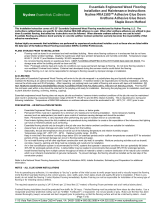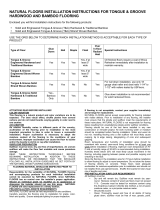
Document ID#: VBHF062320_SOLID
INSTALLER / OWNER RESPONSIBILITY—VERY IMPORTANT
INSTALLATION CONSTITUTES ACCEPTANCE of flooring material,
subfloor/substrate, the jobsite itself including the ambient temperature and relative
humidity at the time of installation, moisture content of the subflooring and flooring,
and all impacting variables that may affect a wood floor. It is the responsibility of both
the installer and owner to inspect and approve each piece of flooring prior to
installation. IF THE FLOORING AS SUPPLIED WILL NOT SATISFY THE
CUSTOMER IN FULL, DO NOT PROCEED TO INSTALL. The decision not to
proceed must be made within the first 10% or 100 square feet of flooring opened,
whichever is less. Industry standards allow a variance from grading and manufacturing
tolerances of 5%.
Note to Installers: Protect your business. Your hard work testing moisture conditions is
lost if you can’t prove it on request. It is now recommended you photograph moisture
readings from two meters, including noting the location, date, and initials on the
subfloor in permanent marker. This is a permanent record of your work that can protect
you if you are ever challenged to prove you did your job completely and correctly.
Many important decisions must be made at the installation site, and therefore must be
the sole responsibility of the installer/owner. These include but are not limited to proper
storage and handling, complete evaluation of site conditions including moisture testing
of the subfloor and flooring, acclimation of flooring to appropriate conditions, subfloor
preparation, flooring layout, milling, grade, color and gloss, scraping, proper
installation methods, sufficient quantity on hand to complete the job, and jobsite
cleanup. For best results, we suggest using a National Wood Flooring Association
Certified Professional to install your floor. A list of active NWFA Certified Professionals
in your area can be found online at www.nwfacp.org
Site Conditions, Handling, and Storage (NWFA Installation Guidelines, Sec. I):
Solid hardwood flooring may be installed above or on grade, not below grade.
Hardwood flooring should be installed after all other construction that may affect them
is completed. Concrete, drywall, plumbing and any other “wet work” should be
thoroughly cured. Factory finished flooring is finished woodwork, handle carefully to
avoid damage.

Document ID#: VBHF062320_SOLID
SOLID HARDWOOD FLOORING IS NOT APPROVED FOR INSTALLATION
OVER RADIANT OR IN-FLOOR HEATING SYSTEMS
Keep flooring dry, flat, and maintain good air circulation in storage. RECORD
SUBFLOOR AND FLOORING MOISTURE CONTENT UPON DELIVERY AND AT
TIME OF INSTALLATION AND RETAIN THESE RECORDS.
Acclimate Solid Hardwood Flooring to controlled site conditions; refer to NWFA
Installation Guidelines, Sec. I, Ch. 2 for detailed information.
HVAC must be in operation before, during, and after installation (refer to NWFA
Installation Guidelines, Sec. I, Ch. 1, Part 1). A temperature of 70 degrees F +/- 10
degrees and a relative humidity between 30-50% is recommended. Heating units or
uninsulated ductwork close to the flooring or subfloor may cause “hot spots” which
must be eliminated prior to installation.
Moisture testing is critical (refer to NWFA Installation Guidelines, Sec. I, Ch. 3).
Confirm proper drainage exists around the structure. In crawl spaces, exposed earth
must be fully covered with minimum 6-mil polyethylene sheeting. Crawl space vents
must be open at all times and must equal at least 1.5% of the total square footage of the
crawl space. Basements must be dry and remain dry.
Subfloor Types and Conditions (NWFA Installation Guidelines, Sec. II)
General:
The subfloor must be clean, dry, flat (within 3/16” in 10’), and structurally sound.
Correct any joints or areas that are not flat. Secure any loose boards or panels.
Wood: (refer to NWFA Installation Guidelines, Sec. II, Ch. 4)
CD Exposure 1 plywood and OSB Exposure 1 subfloor panels are appropriate subfloor
materials (grade stamped US PS1-95). Solid board subfloors should be 1” x 6” nominal,
Group 1 dense softwoods, #2 Common, KD. Minimum single layer subfloor thickness is
5/8” for plywood panels and ¾” OSB on 16” O.C. Joists or 3/4” on 19.2” O.C. Joists and
7/8” on 24” O.C. Joists. Particle board panels will not properly hold fasteners and no
claim with regard to noise when walked upon will be accepted. The flooring must run
perpendicular to the floor joists, or additional subfloor thickness is required (1/2”
plywood or equivalent product). Hardwood flooring should be between 6 and 9%

Document ID#: VBHF062320_SOLID
moisture content, and the subfloor should be within 4% of flooring m.c. (2% on 3-1/4”
or wider flooring). In no case should any wood moisture reading exceed 12%.
Concrete: (refer to NWFA Installation Guidelines, Sec.II, Ch. 5 & 6)
Somerset solid hardwood flooring may be installed over concrete subfloors when using
a plywood over concrete system; refer to NWFA for details on alternate installation
methods. NWFA Installation Guidelines, Section I, Ch. 3, Part 3 should be consulted
carefully.
Installation (NWFA Installation Guidelines, Sec. III, Ch. 9)
Preparation
Allow 3/4” expansion space between the wood flooring and any walls or other
obstructions. Undercut doorjambs, casings, drywall, etc. Over the subfloor, install a
layer of #15 building felt (or equivalent perm rating), overlapped 4” at the seams. See
NWFA, Sec. I, Ch. 3, Part 2-A for more detail on acceptable moisture barriers.
Layout
The best appearance is usually achieved by installing parallel to the length of the room,
but always install perpendicular to the floor joists unless special subfloor conditions are
met (see wood subfloors). While each job is unique, it is critical
to establish a primary working line for the entire job (usually through the longest
continuous area to be installed) and reference all flooring layout from that line. Always
rack out the flooring before installing to avoid clustered end joints and repeating
patterns. Rack out the entire job to assure you have enough flooring to complete the
entire job and that the stain color is consistent. End joints of adjacent rows should be 6”-
8” apart also avoid a stair-stepping appearance of joints and H-Joints when possible
Multiple Width Products
Some products produced come with 3 separate widths, the cartons are packaged so that
there is the same linear feet of each width in each carton. The pattern to be followed
most be a combination of the 3 separate widths (for instance, if you product comes in
widths of 3”, 4”, 5”, then the pattern should be 3”,4”,5”3”,4”,5”, etc or combination of
the 3 repeating widths). If the pattern calls for 5” plank for instance next to a wall or
other obstruction, Do not substitute a narrower width, otherwise you may run out of
the required width in your pattern when completing your installation

Document ID#: VBHF062320_SOLID
Fastening
Use caution to avoid edge and face damage during installation. Special footer plates are
available for flooring tools to protect factory finished flooring faces and edges.
Use backer boards of 1/2” plywood ripped to an appropriate width to establish straight
lines. Backer boards should be secured to the subfloor and carefully aligned with starter
lines.
Use flooring fasteners (cleat or staple) with a preferred length of 2” (plywood over
concrete would be 1 ½” in length) designed for solid hardwood flooring. Air pressure
should be regulated so the fastener seats properly but does not split the tongue or wood
below it.
Nailing schedule is standard per NWFA guidelines, for plank flooring (3 1/4” or wider)
the fastener schedule is every 6”- 8” along the length of the plank and 1”-3” from end
joints. Refer to NWFA Installation Guidelines, Sec IV, Appendix F.
Face nail only as required with 7d or 8d finish nails or cleats, 1/2” from the groove, pre-
drilling the nail holes to prevent splitting. Nailing schedule is 10-12” O.C. Face nails
should be counter sunk and covered by molding or properly filled.
Adhesive/Fastener Installation:
On wider width planks (4” and wider), combining adhesives and fasteners is an option
to minimize flooring movement after installation. For best results apply a perpendicular
bead of adhesive to the subfloor every 6”-8” apart for each row of flooring.
Underlayment paper must be omitted when using adhesives. Use a quality urethane
flooring adhesive recommended by the adhesive manufacturer for solid hardwood
installations. Follow all practices recommended by the adhesive manufacturer
including vapor barrier systems, adhesive temperature, room temperature and
humidity, proper ventilation, spread rate, open time, safety procedures and equipment,
cleanup and cure time. Avoid allowing adhesive residue to dry on the face of the
flooring. Special cleaners are available (from the adhesive manufacturer) to remove any
residue.

Document ID#: VBHF062320_SOLID
Finishing Touches:
Use standard molding profiles factory finished to blend with your hardwood floor.
These moldings will address most trim and transition situations quickly and effectively
and should be ordered with the flooring to avoid needless delays in flooring
completion.
Fill any nail holes or small cracks with the proper filler for factory finished flooring.
Color any nicks and splintered edges with a suitable/like-colored stain marker
Remove all debris and clean the floor thoroughly using a suitable hardwood floor
cleaner. Test any cleaner for finish compatibility before using on installed flooring.
Leave care and maintenance information for the consumer.
If additional work is to be completed after the flooring has been installed, the floors
should be covered completely, wall to wall. DO NOT APPLY ANY TAPE DIRECTLY
TO THE FLOORING SURFACE. DAMAGE CAUSED BY TAPE ADHESION IS NOT
COVERED UNDER TERMS OF THE WARRANTY
Applying additional finish over the factory finish may cause problems and does not
improve durability or seal the joints.
FOR TECHNICAL SUPPORT, PLEASE CALL 800-758-9580
/








